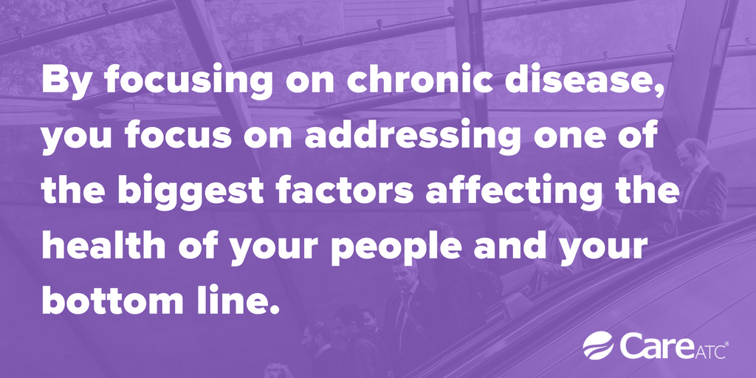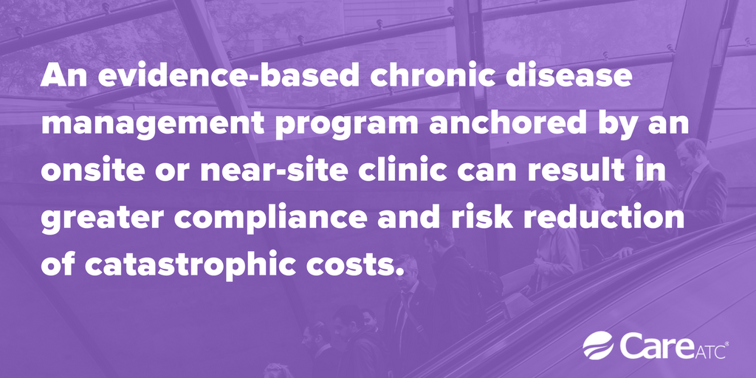If you think the health of your employees has no impact on your productivity or bottom line, think again. One out of every four dollars employers pay for health care is tied to unhealthy lifestyle choices such as smoking, stress, and obesity. Despite spending almost twice as much on health care, the U.S. has the worst health outcomes than most other developed nations. The result is higher medical costs for the U.S. and for employers. So, what gives and how can employers influence behavior for the better?
The Problem
In the largest study of its kind, researchers from the University of Michigan looked at 10 modifiable health risks in roughly 223,500 people across seven industries. In this study, modifiable risks are conditions or behaviors that employees can improve or eliminate by making healthier choices. Can you guess the most prevalent health risk that costs employers the most money? Yup – obesity. Other risks included lack of exercise, blood pressure, cholesterol, and tobacco and alcohol use.
The study found that the average health care cost for a healthy employee was

Another enlightening finding? The extra cost associated with modifiable risks was about the same for healthy employees and those with chronic conditions—which means employers can save money by helping those workers reduce existing health problems.
"There are hundreds of well-designed programs, but thousands of programs that are too superficial to have an impact," says Dr. Michael O'Donnell, lead researcher of the study. "The best programs increase awareness about the link between lifestyle and health, motivate people to change and build the skills necessary to do so, and provide opportunities to practice a healthy lifestyle."
The University of Michigan study provides profound insight into the effect unhealthy employees can have on your bottom-line. The study further illustrates the substantial savings employers might realize by reducing or eliminating health risks through robust and outcomes-based workplace wellness programs. In other words, the more comperehensive your wellness strategy, the greater potential savings you can experience.
The Solution
Wellness programs generally include activities such as company-sponsored exercise, weight-loss competitions, educational seminars, tobacco-cessation programs and health screenings that are designed to help employees eat better, lose weight and improve their overall physical health.
"Employee wellness programs are a win-win for employers and employees. If employees improve their lifestyle, they feel better and reduce their chances of getting sick," says O'Donnell. "Costs go down for employers and their employees, or at least costs do not increase as much as they would otherwise."
Many previous studies have shown that successful wellness programs result in healthier employees and save more in medical care than they cost to design and implement. But could a greater level of strategic investment, especially in addressing existing chronic disease, result in higher efficacy and savings? The answer is absolute. Yes.
While the goal of wellness programs is to prevent disease, the goal of population health management is to improve the health outcomes of your entire employee population – those who are healthy and unhealthy. With population health management programs, you use business intelligence tools to aggregate data and provide a comprehensive clinical picture of your employee population. Employers achieve this level of insight and influence through onsite or near-site primary care clinics.
The Role of Onsite and Near-Site Primary Care Clinics
Think of the last time you went to visit your doctor. Chances are you had to schedule it at a date and time that wasn’t your first choice and maybe cut into your workday. Once you got there, you had to wait a while. Once you were finally called in, you had to wait some more in a big beige (or worse yet, pale pink) sterile box-like room. Finally, the doctor shows up. After what seems like five minutes your appointment ends. Some questions answered, some a bit rushed so the doctor can get to her next appointment. You check out, pay up, maybe might have to expect another bill in the mail - and oh, by the way, you still
With that kind of experience, it’s no wonder that patients in this country (including your employees) aren’t getting the care they need. Lack of time, poor quality, and high cost are all considered barriers to health care. Take these barriers and pair them with chronic disease and you can see why catastrophic health care costs happen all too often.
Fortunately, there is a growing trend of employers who recognize the value of providing access to quality care. In 2014, Mercer’s National Survey of Employer-Sponsored Health Plans found that 29% of employers with 5,000 or more employees provided an onsite or near-site clinic offering primary care services, up from 24% in the prior year. Mercer followed up with these employers in a new, targeted survey on worksite clinics. Of the respondents, 72% of those whose clinics provide general medical services said that managing employee health risk and chronic conditions is an important objective for the clinic. To best assess employee health risk, employers often start with an annual biometric screening.

Annual biometric screenings provide employees with a snapshot of their current health, providing the awareness they need to make healthier choices and track year-over-year progress. On the employer side, aggregate data sheds light on the top risk factors affecting the health of their employee population. Equipped with this knowledge, employers can make data-driven decisions that result in sustainable change. Imagine being able to clearly identify which wellness programs, health coaching programs, and chronic disease management programs will work best for your people – all anchored by a primary care clinic that provides the resources and accountability needed for true change.
By focusing on chronic disease, you focus on addressing one of the biggest factors affecting the health of your people and your bottom line. An evidence-based chronic disease management program anchored by an onsite or near-site clinic can result in greater compliance and risk reduction of catastrophic costs. By tackling the low-hanging fruit of chronic disease, employers can save in the short-term. In fact, for every dollar spent in chronic disease management, $3.80 is saved. Even just a 1% reduction in excess weight and high blood pressure, glucose, and cholesterol levels has been shown to save $83 to $103 annually in medical costs per person.
The great thing is that employer-sponsored clinics aren’t exclusive to large self-funded employers. Small and mid-sized employers are taking advantage of an emerging shared clinic model that provides the same types of benefits to employees and their families. Now employers of all sizes can amplify population health management efforts with an employer-sponsored clinic. By using aggregate data from all of your wellness initiatives, your onsite or shared primary care provider can track, and hopefully improve, outcomes while lowering employer
Related: 5 Benefits of a Shared Clinics
Key Takeaways
- Healthy employees are the key to a productive and profitable business.
- Population health management can help you drive strategic action towards building a healthier workforce.
- Onsite and near-site clinics tackle the biggest barriers to care: lack of time, poor quality, and high cost.
- By tackling the low-hanging fruit of chronic disease, employers can save significantly in the short-term.
- Small and mid-sized employers can take advantage of the emerging shared clinic model.
References
- At a Glance 2015: Workplace Health Promotion. CDC 2015.
- Employers Continue to Launch Worksite Clinics Despite ACA Uncertainties. Mercer, September 2015.
- The Portion of Health Care Costs Associated with Lifestyle-Related Modifiable Health Risks Based on a Sample of 223,461 Employees in Seven Industries. The UM-HMRC Study, 2015.
- The Real ROI for Employee Wellness Programs. SHRM, February 2015.


 Posted by
Posted by



